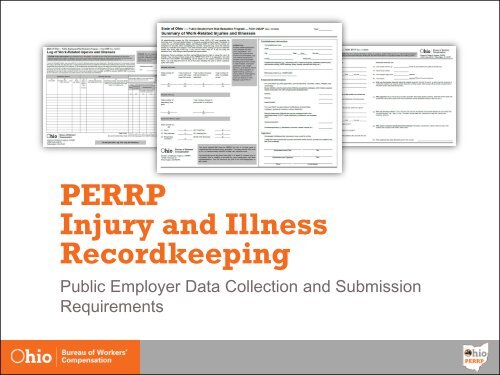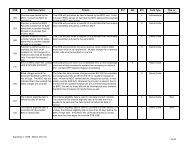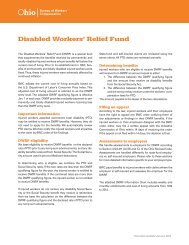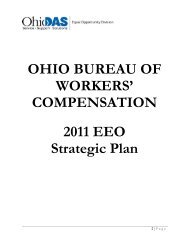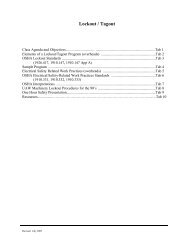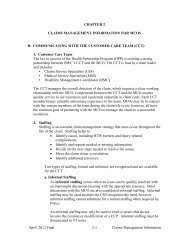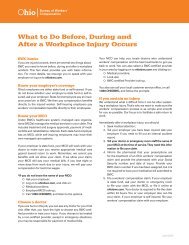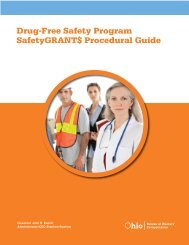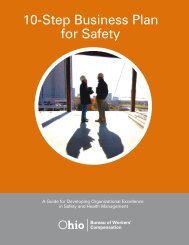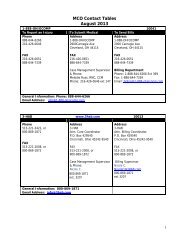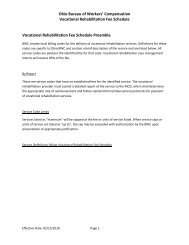PERRP Recordkeeping - Ohio Bureau of Workers' Compensation
PERRP Recordkeeping - Ohio Bureau of Workers' Compensation
PERRP Recordkeeping - Ohio Bureau of Workers' Compensation
You also want an ePaper? Increase the reach of your titles
YUMPU automatically turns print PDFs into web optimized ePapers that Google loves.
<strong>PERRP</strong><br />
Injury and Illness<br />
<strong>Recordkeeping</strong><br />
Public Employer Data Collection and Submission<br />
Requirements
Legal Requirements<br />
o<br />
o<br />
o<br />
o<br />
o<br />
July 1994 Public employers required to maintain injury and illness<br />
recordkeeping forms.<br />
April 2003 <strong>Recordkeeping</strong> amendment requires:<br />
• Public employers to submit five years <strong>of</strong> recordkeeping forms by<br />
October 2003;<br />
• Public Employers required to submit to <strong>PERRP</strong> each year by Feb. 1<br />
for the previous calendar year.<br />
July 2006 <strong>PERRP</strong> introduces <strong>Ohio</strong> specific forms.<br />
February 2009 Failure to post and submit the annual summary results<br />
in the issuance <strong>of</strong> a citation.<br />
2011 <strong>PERRP</strong> notification to employers <strong>of</strong> non-compliance.<br />
2<br />
<strong>PERRP</strong> <strong>Recordkeeping</strong>
Purpose <strong>of</strong> the Rule<br />
o To gather injury and illness data collection and<br />
analysis.<br />
o Public employers in <strong>Ohio</strong> are required to record and<br />
report work-related fatalities, injuries and illnesses.<br />
• Note: Recording or reporting a work-related injury, illness, or<br />
fatality does not mean the employer or employee was at<br />
fault, a <strong>PERRP</strong> rule has been violated, or that the employee<br />
is eligible for workers’ compensation or other benefits.<br />
o <strong>PERRP</strong> injury and illness recordkeeping and the<br />
BWC claims process are independent <strong>of</strong> each other.<br />
3<br />
<strong>PERRP</strong> <strong>Recordkeeping</strong>
ORC 4167.11 (B)<br />
o To implement and maintain the statistics<br />
program, BWC Board <strong>of</strong> Directors are required<br />
to adopt rules that require public employers to:<br />
• “Make, keep, and preserve, and make available”,<br />
necessary reports and records appropriate for<br />
standards enforcement or for developing information<br />
regarding the causes and prevention <strong>of</strong> occupational<br />
accidents and illnesses.<br />
o The OAC explains how to comply with the ORC<br />
requirements.<br />
4<br />
<strong>PERRP</strong> <strong>Recordkeeping</strong>
OAC <strong>Recordkeeping</strong> Rule<br />
o 6-01: Records maintained by calendar year<br />
o 6-02: Log and Summary<br />
o 6-03: Supplementary Record<br />
o 6-04: Annual Summary<br />
o 6-05: Falsification <strong>of</strong> Records<br />
o 6-06: BWC Reporting (Reserved)<br />
o 6-07: Retention <strong>of</strong> Records<br />
o 6-08: Access to Records<br />
o 6-09: Monitoring Records<br />
o 6-10: Reporting <strong>of</strong> Fatalities and Catastrophes<br />
5<br />
<strong>PERRP</strong> <strong>Recordkeeping</strong>
Basic Requirements<br />
o Public employers are required to maintain a<br />
log and summary.<br />
o Public employers are required to submit the<br />
<strong>PERRP</strong> 300AP form each year by Feb. 1.<br />
o Public employers are required to post a copy<br />
<strong>of</strong> the <strong>PERRP</strong> 300AP form for each<br />
establishment.<br />
6<br />
<strong>PERRP</strong> <strong>Recordkeeping</strong>
Covered Employees<br />
o Employees on payroll<br />
o Employees <strong>of</strong> non-pr<strong>of</strong>it boards that are supervised by<br />
public employees (Developmental Disabilities, etc.)<br />
o Employees not on payroll who are supervised on a dayto-day<br />
basis (temporary employment)<br />
• Temporary help agencies only record their employee<br />
injuries when they are under their supervision. Injuries<br />
<strong>of</strong> temp workers who are supervised by a public<br />
employer must be recorded by the public employer.<br />
o Exclude volunteers and restitution workers<br />
7<br />
<strong>PERRP</strong> <strong>Recordkeeping</strong>
<strong>Recordkeeping</strong><br />
Exemptions<br />
o There are no exemptions for public<br />
employers<br />
o There are no exemptions for small public<br />
employers, schools, and medical facilities<br />
o All public employers must comply with the<br />
recordkeeping rules adopted by <strong>PERRP</strong><br />
8<br />
<strong>PERRP</strong> <strong>Recordkeeping</strong>
Multiple Establishments<br />
o Employers must keep a separate log and summary for each<br />
establishment.<br />
o Establishment is defined as:<br />
• A single physical location where business is conducted;<br />
• Where services or industrial operations are performed.<br />
o Establishment logs can be maintained in a central location, if:<br />
• Incidents are reported to the central <strong>of</strong>fice within six calendar<br />
days;<br />
• Updated copies <strong>of</strong> the “Log” are provided to each<br />
establishment quarterly.<br />
9<br />
<strong>PERRP</strong> <strong>Recordkeeping</strong>
Required Forms<br />
o The <strong>Ohio</strong> Administrative Code requires the use <strong>of</strong><br />
the following <strong>PERRP</strong> recordkeeping forms:<br />
• <strong>PERRP</strong> Form 300P Log;<br />
• <strong>PERRP</strong> Form 300AP Summary;<br />
• <strong>PERRP</strong> Form 301P Incident Report.<br />
o BWC First Report <strong>of</strong> Injury (FROI) is “equivalent” to<br />
301P.<br />
o <strong>PERRP</strong> has developed its own set <strong>of</strong> recordkeeping<br />
forms that are “equivalent” to the OSHA forms.<br />
10<br />
<strong>PERRP</strong> <strong>Recordkeeping</strong>
ORC 4167.11 (B)<br />
Public employers are also required to:<br />
o Post notices or otherwise “keep their<br />
public employees informed” <strong>of</strong> their<br />
rights and obligations;<br />
o Maintain accurate records <strong>of</strong> public<br />
employee exposure to potentially<br />
toxic materials, carcinogenic<br />
materials, and harmful physical<br />
agents.<br />
11<br />
<strong>PERRP</strong> <strong>Recordkeeping</strong>
Filling Out Forms<br />
You must follow the instructions!<br />
12<br />
<strong>PERRP</strong> <strong>Recordkeeping</strong>
<strong>Recordkeeping</strong><br />
Instructions<br />
o <strong>PERRP</strong> has created a set <strong>of</strong> instructions to<br />
help public employers understand and apply<br />
the recording criteria.<br />
o <strong>PERRP</strong> instructions are similar to the<br />
Federal OSHA instructions but are specific to<br />
public employers.<br />
13<br />
<strong>PERRP</strong> <strong>Recordkeeping</strong>
<strong>Recordkeeping</strong> Step 1<br />
o Injury and Illness Incident Report<br />
• Public employers are required to collect basic<br />
information for each injury and illness incident.<br />
o Acceptable forms<br />
• <strong>PERRP</strong> 301P<br />
• BWC First Report <strong>of</strong> Injury (FROI)<br />
• Employer accident form<br />
14<br />
<strong>PERRP</strong> <strong>Recordkeeping</strong>
<strong>PERRP</strong> Form 301P Injury and<br />
Illness Incident Report<br />
<strong>PERRP</strong> <strong>Recordkeeping</strong>
BWC First Report<br />
<strong>of</strong> Injury (FROI)<br />
<strong>PERRP</strong> <strong>Recordkeeping</strong>
<strong>Recordkeeping</strong> Step 2<br />
o Log <strong>of</strong> work related injuries and<br />
illnesses<br />
• Public employers are required to record and<br />
maintain information about their most serious<br />
injuries and illnesses.<br />
o Acceptable forms<br />
• <strong>PERRP</strong> 300P<br />
• Employer form (hard copy or electronic) that<br />
includes all required information<br />
17<br />
<strong>PERRP</strong> <strong>Recordkeeping</strong>
<strong>PERRP</strong> 300P Log Of Work-<br />
Related Injuries and Illnesses<br />
18<br />
<strong>PERRP</strong> <strong>Recordkeeping</strong>
Recording Criteria<br />
o Public employers must record each fatality,<br />
injury or illness that:<br />
• Is work-related;<br />
• Is a new case;<br />
• Meets one or more <strong>of</strong> the criteria contained in the<br />
<strong>PERRP</strong> recordkeeping instructions.<br />
19<br />
<strong>PERRP</strong> <strong>Recordkeeping</strong>
Recording Criteria Decision Tree<br />
Do not record the<br />
injury or illness<br />
NO<br />
NO<br />
NO<br />
NO<br />
Did the employee<br />
experience an<br />
injury or illness?<br />
YES<br />
Is the injury or<br />
illness work<br />
related?<br />
YES<br />
Is the injury or<br />
illness a new case?<br />
YES<br />
Does the injury or<br />
illness meet the<br />
general recording<br />
criteria or the<br />
diagnosis <strong>of</strong><br />
significant I or I?<br />
NO<br />
YES<br />
Record the injury or<br />
illness<br />
Update the<br />
previously recorded<br />
injury or illness<br />
entry (if necessary)<br />
20<br />
<strong>PERRP</strong> <strong>Recordkeeping</strong>
Work-Relatedness<br />
o Cases are work-related if:<br />
• An event or exposure in the work environment<br />
either caused or contributed to the resulting<br />
condition;<br />
• An event or exposure in the work environment<br />
significantly aggravated a pre-existing injury or<br />
illness.<br />
21<br />
<strong>PERRP</strong> <strong>Recordkeeping</strong>
Work Environment<br />
o Injuries and illnesses are work-related if they:<br />
• Occur while the employee is performing work for<br />
pay or compensation in the home;<br />
• Are directly related to the performance <strong>of</strong> work<br />
rather than the general home environment;<br />
• Occur during work-related activities while an<br />
employee is on work-related travel.<br />
22<br />
<strong>PERRP</strong> <strong>Recordkeeping</strong>
Work-Relatedness<br />
o Work-relatedness is presumed for injuries and<br />
illnesses resulting from events or exposures<br />
occurring in the work environment.<br />
o A case is presumed work-related if, and only if, an<br />
event or exposure in the work environment is a<br />
discernable cause <strong>of</strong> the injury or illness or <strong>of</strong> a<br />
significant aggravation to a pre-existing condition.<br />
o The work event or exposure only needs to be one <strong>of</strong><br />
the causes; it does not need to be the sole or<br />
predominant cause.<br />
23<br />
<strong>PERRP</strong> <strong>Recordkeeping</strong>
Work-Related Exceptions<br />
There are nine exceptions to the definition <strong>of</strong> work-related to limit recording<br />
<strong>of</strong> cases involving:<br />
1. Eating, drinking, or preparing food or drink for personal consumption;<br />
2. Common colds and flu;<br />
3. Voluntary participation in wellness or fitness program;<br />
4. Personal grooming or self-medication;<br />
5. General public (visiting, personal business, etc.);<br />
6. Symptoms <strong>of</strong> non-work related injury/illness;<br />
7. Commuting;<br />
8. Personal tasks;<br />
9. Mental illness.<br />
24<br />
<strong>PERRP</strong> <strong>Recordkeeping</strong>
Significant Aggravation<br />
o A pre-existing injury or illness is significantly<br />
aggravated when an event or exposure in<br />
the work environment results in any <strong>of</strong> the<br />
following; which otherwise would not have<br />
occurred:<br />
• Death;<br />
• Loss <strong>of</strong> consciousness;<br />
• Days away, days <strong>of</strong> restriction or job transfer;<br />
• Medical treatment.<br />
25<br />
<strong>PERRP</strong> <strong>Recordkeeping</strong>
General Recording Criteria<br />
o Requires records to include any work-related<br />
injury or illness resulting in one <strong>of</strong> the following:<br />
• Death;<br />
• Days away from work;<br />
• Restricted work or transfer to another job;<br />
• Medical treatment beyond first aid;<br />
• Loss <strong>of</strong> consciousness;<br />
• Diagnosis <strong>of</strong> a significant injury/illness by a physician or<br />
other practicing licensed health care pr<strong>of</strong>essional<br />
(PLHCP).<br />
26<br />
<strong>PERRP</strong> <strong>Recordkeeping</strong>
Medical Treatment<br />
o Medical treatment is the management and<br />
care <strong>of</strong> a patient to combat disease or<br />
disorder.<br />
o It does not include:<br />
• Visits to a PLHCP solely for observation or<br />
counseling;<br />
• Diagnostic procedures;<br />
• First aid.<br />
27<br />
<strong>PERRP</strong> <strong>Recordkeeping</strong>
First Aid<br />
o Using nonprescription medication at nonprescription<br />
strength<br />
o Tetanus immunizations<br />
o Cleaning, flushing, or soaking surface wounds<br />
o Wound coverings, butterfly bandages, Steri-Strips<br />
o Hot or cold therapy<br />
o Non-rigid means <strong>of</strong> support<br />
o Temporary immobilization device used to transport<br />
accident victims<br />
28<br />
<strong>PERRP</strong> <strong>Recordkeeping</strong>
First Aid (continued)<br />
o Drilling <strong>of</strong> fingernail or toenail, draining fluid from<br />
blister<br />
o Eye patches<br />
o Removing foreign bodies from eye using irrigation or<br />
cotton swab<br />
o Removing splinters or foreign material from areas<br />
other than the eye by irrigation, tweezers, cotton<br />
swabs or other simple means<br />
o Finger guards<br />
o Massages<br />
o Drinking fluids for relief <strong>of</strong> heat stress<br />
29<br />
<strong>PERRP</strong> <strong>Recordkeeping</strong>
Significant Diagnosed<br />
Injury or Illness<br />
o The following work-related conditions must<br />
always be recorded at the time <strong>of</strong> diagnosis<br />
by a PLHCP:<br />
• Cancer;<br />
• Chronic irreversible disease;<br />
• Punctured eardrum;<br />
• Fractured or cracked bone or tooth.<br />
30<br />
<strong>PERRP</strong> <strong>Recordkeeping</strong>
New Case<br />
o A case is new if the employee:<br />
• Has not previously experienced a recordable injury<br />
or illness <strong>of</strong> the same type that affects the same<br />
part <strong>of</strong> the body; or<br />
• Previously experienced a recordable injury or<br />
illness <strong>of</strong> the same type that affects the same part<br />
<strong>of</strong> the body, but had recovered completely and an<br />
event or exposure in the work environment caused<br />
the signs and symptoms to reappear;<br />
31<br />
<strong>PERRP</strong> <strong>Recordkeeping</strong>
New Case (continued)<br />
o If there is a medical opinion regarding<br />
resolution <strong>of</strong> a case, the employer must<br />
follow that opinion;<br />
o If an exposure triggers the recurrence, it is a<br />
new case (e.g., asthma, dermatitis);<br />
o If signs and symptoms recur even in the<br />
absence <strong>of</strong> exposure, it is not a new case<br />
(e.g., silicosis, tuberculosis, asbestosis).<br />
32<br />
<strong>PERRP</strong> <strong>Recordkeeping</strong>
Employee Privacy<br />
o Prohibits employers from entering an individual’s name on<br />
Form 300 for certain types <strong>of</strong> injuries/illnesses (enter<br />
“privacy case”)<br />
o Provides employers the right not to describe the nature <strong>of</strong><br />
sensitive injuries where the employee’s identity would be<br />
known<br />
o Gives employee representatives access only to the portion<br />
<strong>of</strong> Form 301P which contains no personal information<br />
o Requires employers to remove employees’ names before<br />
providing the data to persons not provided access rights<br />
under the rule<br />
33<br />
<strong>PERRP</strong> <strong>Recordkeeping</strong>
Privacy Cases<br />
o This is the complete list <strong>of</strong> all injuries and illnesses considered<br />
privacy concern cases for the purposes <strong>of</strong> <strong>PERRP</strong><br />
recordkeeping:<br />
• An injury or illness to an intimate body part or the<br />
reproductive system;<br />
• An injury or illness resulting from a sexual assault;<br />
• Mental illnesses;<br />
• HIV infection, hepatitis, or tuberculosis;<br />
• Needlestick injuries and cuts from sharp objects that are<br />
contaminated with another person's blood or OPIM;<br />
• Other illnesses, if the employee voluntarily requests that his<br />
or her name not be entered on the log.<br />
34<br />
<strong>PERRP</strong> <strong>Recordkeeping</strong>
Bloodborne Pathogens<br />
o Record all work-related needlesticks and cuts from sharp<br />
objects that are contaminated with another person’s<br />
blood or other potentially infectious material (includes<br />
human bodily fluids, tissues and organs; other materials<br />
potentially infected with HIV, Hepatitis B, or other<br />
pathogens such as laboratory cultures).<br />
o Other sharps injuries (from uncontaminated objects)<br />
would only be recordable if medical treatment beyond<br />
first aid was required.<br />
o Record splashes or other exposures to blood or other<br />
potentially infectious material if it results in diagnosis <strong>of</strong> a<br />
bloodborne disease or meets the general recording<br />
criteria.<br />
35<br />
<strong>PERRP</strong> <strong>Recordkeeping</strong>
Hearing Loss<br />
o All work-related hearing loss cases must<br />
be recorded when:<br />
• Employee has experienced a Standard<br />
Threshold Shift (STS) 1 ;<br />
• Employee’s total hearing level is 25<br />
decibels (dB) or more above audiometric<br />
zero in the same ear(s) as the STS;<br />
• Determine if the case meets this criteria<br />
then record the hearing loss on the date<br />
<strong>of</strong> diagnosis.<br />
o Check column M5 on the 300P.<br />
1<br />
A STS is defined in OSHA’s noise standard at 29 CFR 1910.95(g)(10)(i) as a change in hearing threshold, relative to<br />
the baseline audiogram, <strong>of</strong> an average <strong>of</strong> 10 dB or more at 2000, 3000, and 4000 Hz in one or both ears. 36<br />
<strong>PERRP</strong> <strong>Recordkeeping</strong>
Musculoskeletal Disorders<br />
o Applies the same recording criteria to<br />
musculoskeletal disorders (MSDs) as to all<br />
other injuries and illnesses<br />
o Employer retains flexibility to determine<br />
whether an event or exposure in the work<br />
environment caused or contributed to the<br />
MSD<br />
37<br />
<strong>PERRP</strong> <strong>Recordkeeping</strong>
Day Counts<br />
o Focuses on days away or days <strong>of</strong> restriction<br />
or job transfer<br />
o Rules for counting rely on calendar days<br />
instead <strong>of</strong> workdays<br />
• Easier to calculate<br />
• More consistent data<br />
• Better measure <strong>of</strong> severity<br />
38<br />
<strong>PERRP</strong> <strong>Recordkeeping</strong>
Days Away Cases<br />
o Day counts (days away or days restricted)<br />
• Count the number <strong>of</strong> calendar days the<br />
employee was unable to work (include<br />
weekend days, holidays, vacation days,<br />
etc.)<br />
• Cap day count at 180 days away and/or<br />
days restricted<br />
• May stop day count if employee leaves<br />
your employment for a reason unrelated to<br />
the injury or illness<br />
• If a medical opinion exists, employer must<br />
follow that opinion<br />
39<br />
<strong>PERRP</strong> <strong>Recordkeeping</strong>
Recording Days Away<br />
o Record if the case<br />
involves one or more<br />
days away from work<br />
o Do not include the<br />
day <strong>of</strong> injury/illness<br />
o Check the box in<br />
column “H” for days<br />
away cases<br />
o Count the number <strong>of</strong><br />
days and enter in<br />
column “K”<br />
40<br />
<strong>PERRP</strong> <strong>Recordkeeping</strong>
Restricted Work Cases<br />
o Restricted work activity exists if the<br />
employee is:<br />
• Unable to work the full workday he or she would<br />
otherwise have been scheduled to work; or<br />
• Unable to perform one or more routine job<br />
functions.<br />
o An employee’s routine job functions are<br />
those activities the employee regularly<br />
performs at least once per week.<br />
41<br />
<strong>PERRP</strong> <strong>Recordkeeping</strong>
Restricted Work Exceptions<br />
A case is not recordable as a restricted work<br />
case if :<br />
o The employee experiences minor<br />
musculoskeletal discomfort;<br />
o A health care pr<strong>of</strong>essional determines that<br />
the employee is fully able to perform all <strong>of</strong> his<br />
or her routine job functions.<br />
42<br />
<strong>PERRP</strong> <strong>Recordkeeping</strong>
Recording Restricted Work<br />
o Record if the case<br />
involves one or more<br />
days <strong>of</strong> restricted work<br />
or job transfer<br />
o Do not include the day<br />
<strong>of</strong> injury/illness<br />
o Check the box column<br />
“I” under “remained at<br />
work”<br />
o Count the number <strong>of</strong><br />
days and enter in<br />
column “L”<br />
43<br />
<strong>PERRP</strong> <strong>Recordkeeping</strong>
Job Transfer<br />
o An injured or ill employee is assigned to a<br />
job other than his or her regular job for part<br />
<strong>of</strong> the day<br />
o A case is recordable if the injured or ill<br />
employee performs his or her routine job<br />
duties for part <strong>of</strong> a day and is assigned to<br />
another job for the rest <strong>of</strong> the day<br />
44<br />
<strong>PERRP</strong> <strong>Recordkeeping</strong>
Other Recordable Cases<br />
o If a case does not involve a death, days<br />
away, days <strong>of</strong> restriction or job transfer then<br />
it may be an “other” recordable case.<br />
o An other recordable case (Column J) is one<br />
that requires medical treatment beyond first<br />
aid but does not meet any other recording<br />
criteria.<br />
45<br />
<strong>PERRP</strong> <strong>Recordkeeping</strong>
Tuberculosis and<br />
Medical Removal<br />
o Includes separate provisions describing the<br />
recording criteria for cases involving the<br />
work-related transmission <strong>of</strong> tuberculosis<br />
o Requires employers to record cases <strong>of</strong><br />
medical removal under one <strong>of</strong> the toxic or<br />
hazardous substance standards<br />
• Further exposure would place the employee at<br />
increased risk <strong>of</strong> material impairment to their<br />
health<br />
46<br />
<strong>PERRP</strong> <strong>Recordkeeping</strong>
300P Example<br />
<strong>PERRP</strong> <strong>Recordkeeping</strong>
300P Example<br />
<strong>PERRP</strong> <strong>Recordkeeping</strong>
300P Example<br />
49<br />
<strong>PERRP</strong> <strong>Recordkeeping</strong>
300AP Annual Summary<br />
o Must be certified<br />
o Must be posted<br />
o Must be<br />
submitted to<br />
<strong>PERRP</strong><br />
50<br />
<strong>PERRP</strong> <strong>Recordkeeping</strong>
300AP Completion<br />
o Before completing each 300AP:<br />
• Review 300P Log for completeness and accuracy<br />
• Complete 300AP<br />
• Certify 300AP<br />
o Total all 300P columns and transfer to<br />
corresponding 300AP fields<br />
o NOTE: Information on the 300AP can be<br />
used to complete the annual BWC Safety<br />
Council Semi-Annual Report<br />
51<br />
<strong>PERRP</strong> <strong>Recordkeeping</strong>
300AP Posting<br />
o Post individual 300AP for each<br />
establishment<br />
o Must be posted from Feb. 1 to April 30 each<br />
year following the year covered by the<br />
300AP<br />
o Employer certification must include the<br />
signature and title <strong>of</strong> the authorized<br />
employer representative and date <strong>of</strong><br />
completion<br />
52<br />
<strong>PERRP</strong> <strong>Recordkeeping</strong>
300AP Submission<br />
o Copy <strong>of</strong> annual 300APs must be sent to <strong>PERRP</strong><br />
on or before Feb. 1 <strong>of</strong> each year<br />
• These should be submitted through the <strong>PERRP</strong><br />
website (preferred)<br />
o All 300AP submissions must include the public<br />
employer’s BWC Risk Number<br />
o If you have multiple establishments (locations),<br />
create a “master” 300AP for submission to<br />
<strong>PERRP</strong><br />
53<br />
<strong>PERRP</strong> <strong>Recordkeeping</strong>
Master 300AP<br />
o Employers with multiple establishments are<br />
asked to create a master summary for<br />
<strong>PERRP</strong> submission<br />
o So, one 300AP should be submitted from<br />
each <strong>of</strong> the following:<br />
• Cities, Townships, School Districts, Special<br />
Districts, Villages, and most State Agencies<br />
o There are a few exceptions to the master<br />
summary submission<br />
54<br />
<strong>PERRP</strong> <strong>Recordkeeping</strong>
Master 300AP Exceptions<br />
o The following must submit multiple summaries<br />
• Counties, must submit one for each <strong>of</strong> the following agencies<br />
o Commissioners, Highway Engineer, County Home/Care<br />
Center, County Developmental Disabilities.<br />
• Universities and Colleges<br />
o One 300AP for each campus or branch campus and one<br />
for each medical center/hospital<br />
• ODOT<br />
o One summary for each district<br />
• ODNR<br />
o One summary for each park<br />
• ODRC<br />
o One summary for each correctional facility<br />
55<br />
<strong>PERRP</strong> <strong>Recordkeeping</strong>
300AP Example<br />
56<br />
<strong>PERRP</strong> <strong>Recordkeeping</strong>
300AP Example<br />
Number <strong>of</strong> Cases must = Number <strong>of</strong> Injury and Illness Types<br />
57<br />
<strong>PERRP</strong> <strong>Recordkeeping</strong>
300AP Example<br />
58<br />
<strong>PERRP</strong> <strong>Recordkeeping</strong>
Retention and Updating<br />
o Retain forms for five years following the year<br />
that they cover<br />
o Update the 300P Log during the retention<br />
period<br />
o You do not update the 300AP or 301P during<br />
the five year retention period<br />
59<br />
<strong>PERRP</strong> <strong>Recordkeeping</strong>
Fatality or Multiple<br />
Hospitalization Reporting<br />
o All work-related fatalities or incidents<br />
involving three or more in-patient<br />
hospitalizations must be reported to <strong>PERRP</strong><br />
within eight hours <strong>of</strong> the incident or as soon<br />
as the employer becomes aware.<br />
o Reports must be made in person or by<br />
phone to 800-671-6858.<br />
o Failure to report will result in the issuance <strong>of</strong><br />
a citation.<br />
60<br />
<strong>PERRP</strong> <strong>Recordkeeping</strong>
Fatality Reporting<br />
o You must report and record all work-related<br />
fatalities including highway or public street<br />
motor vehicle accidents and heart attacks.<br />
o <strong>PERRP</strong> may not exercise its right to<br />
investigate vehicular accidents or heart<br />
attacks that result in a fatality.<br />
61<br />
<strong>PERRP</strong> <strong>Recordkeeping</strong>
Employee Access<br />
o Injury and illnesses records must be made<br />
available to:<br />
• <strong>PERRP</strong> representatives for the purposes <strong>of</strong><br />
carrying out the provisions <strong>of</strong> the program; and,<br />
• To any employee, former employee, or employee<br />
representative.<br />
62<br />
<strong>PERRP</strong> <strong>Recordkeeping</strong>
Prohibition<br />
Against Discrimination<br />
o Employers are prohibited from discriminating against<br />
an employee that exercises their rights and<br />
responsibilities under the Act.<br />
• This includes requesting access to injury and illness<br />
recordkeeping information.<br />
o Employees who feel that they have been<br />
discriminated against can:<br />
• File a complaint with the State Personnel Board <strong>of</strong> Review; or<br />
• Pursue a labor grievance; or<br />
• Pursue any other appeal procedure provided.<br />
63<br />
<strong>PERRP</strong> <strong>Recordkeeping</strong>
Falsification and Failure To<br />
Keep Records Or Reports<br />
o A failure to post and submit a copy <strong>of</strong> the<br />
establishment's annual 300AP will result in<br />
the issuance <strong>of</strong> a citation.<br />
o If a false statement, representation, or<br />
certification <strong>of</strong> the required records is<br />
knowingly given, a willful failure to comply<br />
order will be issued.<br />
64<br />
<strong>PERRP</strong> <strong>Recordkeeping</strong>
300AP Certification<br />
65<br />
<strong>PERRP</strong> <strong>Recordkeeping</strong>
The 7 BAD Habits <strong>of</strong><br />
Highly Ineffective<br />
Recordkeepers<br />
Or…<br />
Who wants to be an effective recordkeeper?
“Bad Habit” #1<br />
Total number <strong>of</strong> recordable cases does not<br />
match the total number <strong>of</strong> injury and illness<br />
types<br />
o Only one entry should be made in columns<br />
G, H, I and J for each case<br />
o Only the most severe outcome is recorded<br />
o Verify totals from following columns equal<br />
G+H+I+J = M(1)+M(2)+M(3)+M(4)+M(5)+M(6)<br />
67<br />
<strong>PERRP</strong> <strong>Recordkeeping</strong>
“Bad Habit” #2<br />
Failure to record “other” recordable cases<br />
o Record all cases as “other” that meet the recording<br />
criteria, but do not result in:<br />
• Death<br />
• Days away<br />
• Days <strong>of</strong> restriction or job transfer<br />
o However, not every incident is recordable and not every<br />
BWC compensable claim is recordable<br />
o Research each case carefully and compare the facts to<br />
the recording criteria<br />
68<br />
<strong>PERRP</strong> <strong>Recordkeeping</strong>
“Bad Habit” #3<br />
Failure to properly enter total number <strong>of</strong><br />
employees<br />
o<br />
o<br />
o<br />
o<br />
INCLUDE all elected <strong>of</strong>ficials in your number <strong>of</strong> employees<br />
DO NOT include police (peace <strong>of</strong>ficers), firefighters, paramedics<br />
and EMTs in your total count. These job classifications are listed<br />
on a separate line.<br />
DO NOT include any substitutes in your total counts.<br />
• They “substitute” for permanent positions.<br />
DO NOT include volunteers in your total counts.<br />
• “Public employee” does not mean: any person who engages to furnish services subject<br />
to the direction and control <strong>of</strong> a public employer but does not receive compensation,<br />
either directly or indirectly, for those services.<br />
69<br />
<strong>PERRP</strong> <strong>Recordkeeping</strong>
“Bad Habit” #4<br />
Failure to maintain a 300P and 300AP for<br />
each establishment<br />
o This requirement helps identify specific work<br />
area concerns<br />
o <strong>PERRP</strong> and the employer can then focus on<br />
areas <strong>of</strong> greatest concern<br />
o This will result in a timely resolution <strong>of</strong> safety<br />
and health concerns<br />
70<br />
<strong>PERRP</strong> <strong>Recordkeeping</strong>
“Bad Habit” #5<br />
Failure to certify the 300AP<br />
o Certifying the 300AP ensures that members <strong>of</strong> upper<br />
management are aware <strong>of</strong> the injury and illness trends in<br />
their establishments<br />
o Upper management knowledge is critical in the<br />
development and prioritization <strong>of</strong> safety and health issues<br />
o Management commitment and planning establish a firm<br />
foundation for an effective safety and health program<br />
71<br />
<strong>PERRP</strong> <strong>Recordkeeping</strong>
“Bad Habit” #6<br />
Failure to “post” the 300AP<br />
o Post the summary from February 1 to April<br />
30 every year, even if you do not have any<br />
recordable injuries (zero 300AP)!<br />
o Employees must be informed <strong>of</strong> the nature<br />
and frequency <strong>of</strong> workplace injuries and<br />
illnesses<br />
o Communication is key to the success <strong>of</strong> a<br />
safety and health program<br />
72<br />
<strong>PERRP</strong> <strong>Recordkeeping</strong>
“Bad Habit” #7<br />
Failure to “submit” the 300AP<br />
o This provides the employer and <strong>PERRP</strong> with a<br />
snapshot <strong>of</strong> overall concerns in the workplace<br />
o Helps the employer and <strong>PERRP</strong> compare<br />
incidences across public employment sectors<br />
o Helps <strong>PERRP</strong> concentrate on areas <strong>of</strong> concern<br />
and develop effective compliance assistance<br />
activities to prevent public employment injuries<br />
and illnesses<br />
73<br />
<strong>PERRP</strong> <strong>Recordkeeping</strong>
The 7 “Bad Habits”<br />
1. Total number <strong>of</strong> recordable cases does not match the<br />
total number <strong>of</strong> injury and illness types<br />
2. Failure to record “other” recordable cases<br />
3. Failure to properly enter “total number <strong>of</strong> employees”<br />
4. Failure to maintain a 300P and 300AP for each<br />
establishment<br />
5. Failure to certify the 300AP<br />
6. Failure to post the 300AP<br />
7. Failure to “submit” the 300AP<br />
74<br />
<strong>PERRP</strong> <strong>Recordkeeping</strong>
Injury and Illness<br />
<strong>Recordkeeping</strong> Scenarios<br />
Examples <strong>of</strong> how to properly record workplace incidents
Scenario 1<br />
Bob is a county employee, his headquarters is<br />
home-based. Bob is moving a file box full <strong>of</strong><br />
work related documents at his home <strong>of</strong>fice and<br />
drops the file box on his foot and breaks his<br />
toe.<br />
Is this injury recordable on his employer’s 300P<br />
log?<br />
76<br />
<strong>PERRP</strong> <strong>Recordkeeping</strong>
Answer 1<br />
Yes.<br />
<strong>PERRP</strong> considers injuries and illnesses that<br />
occur while an employee is working at home,<br />
including work in a home <strong>of</strong>fice, work related if<br />
the injury or illness occurs while the employee<br />
is performing work for pay or compensation in<br />
the home.<br />
77<br />
<strong>PERRP</strong> <strong>Recordkeeping</strong>
Scenario 2<br />
Employee was driving to a school building to conduct<br />
an inspection. During his commute, he hit a deer with<br />
his vehicle. He hit his head on the windshield and was<br />
unconscious for few minutes but became conscious<br />
before the ambulance arrived. He was taken to the<br />
nearest hospital for observation and was sent home.<br />
The employee returned to work the next day.<br />
Is this injury recordable on his employer’s 300P log?<br />
78<br />
<strong>PERRP</strong> <strong>Recordkeeping</strong>
Answer 2<br />
Yes.<br />
<strong>PERRP</strong> considers any case involving a loss <strong>of</strong><br />
consciousness to be recordable.<br />
79<br />
<strong>PERRP</strong> <strong>Recordkeeping</strong>
Scenario 3<br />
Mike normally reports to his local <strong>of</strong>fice,<br />
however he is required to report to the Central<br />
Office for a week to work on a project. Mike<br />
checks into a hotel on Monday. On Tuesday<br />
morning Mike is driving to the Central Office<br />
and is involved in an accident that requires him<br />
to be hospitalized.<br />
Is this incident work related?<br />
80<br />
<strong>PERRP</strong> <strong>Recordkeeping</strong>
Answer 3<br />
No.<br />
If the employee has established a home<br />
away from home and is reporting to a fixed<br />
worksite each day, you do not consider<br />
injuries or illnesses work-related if they<br />
occur while the employee is commuting<br />
between the temporary residence and the<br />
job location.<br />
81<br />
<strong>PERRP</strong> <strong>Recordkeeping</strong>
Scenario 4<br />
Shelly is a firefighter for a small town in <strong>Ohio</strong>.<br />
Shelly is at a fire scene and receives burns to<br />
her arms that require medical treatment.<br />
Is her employer required to keep a <strong>PERRP</strong><br />
300P Log and record her injuries?<br />
82<br />
<strong>PERRP</strong> <strong>Recordkeeping</strong>
Answer 4<br />
Yes.<br />
All work related injuries and illnesses to<br />
Firefighters, EMTs and Police Officers are to<br />
be recorded on their employer’s 300P log.<br />
83<br />
<strong>PERRP</strong> <strong>Recordkeeping</strong>
Scenario 5<br />
Terry is a part-time seasonal employee for<br />
Greenacres State Park. While working on<br />
some equipment, Terry cuts his finger and<br />
goes to the hospital where the doctor gives him<br />
a tetanus shot and applies a butterfly bandage<br />
to the wound.<br />
Is this a recordable injury?<br />
84<br />
<strong>PERRP</strong> <strong>Recordkeeping</strong>
Answer 5<br />
No.<br />
Not because Terry is only part-time or a<br />
seasonal employee, but because both a<br />
tetanus shot and a butterfly bandage are<br />
considered first aid not medical treatment.<br />
85<br />
<strong>PERRP</strong> <strong>Recordkeeping</strong>
Scenario 6<br />
John is a janitor and while moving the cafeteria<br />
table he strained his back. The physician<br />
prescribed medication and released him from<br />
work for 3 days. John went back to work after<br />
the 3 days but was on job restriction for 7 more<br />
days.<br />
Is this recordable? If so, do you record it as a<br />
case with days away or restriction?<br />
86<br />
<strong>PERRP</strong> <strong>Recordkeeping</strong>
Answer 6<br />
Yes.<br />
Prescribed medication is recordable. Days<br />
away from work and restricted days are also<br />
recordable. This case would be recorded as<br />
days away from work. Whenever you have a<br />
case that has one day away from work, you<br />
record it as days away from work since it is the<br />
most serious regardless <strong>of</strong> how many restricted<br />
days.<br />
87<br />
<strong>PERRP</strong> <strong>Recordkeeping</strong>
Scenario 7<br />
Becky works in the cafeteria at the school and<br />
she cut her finger with a knife at 6 AM. She<br />
went to the hospital and received stitches. She<br />
returned back to work the next day.<br />
Is this recordable?<br />
88<br />
<strong>PERRP</strong> <strong>Recordkeeping</strong>
Answer 7<br />
Yes.<br />
Stitches are recordable.<br />
89<br />
<strong>PERRP</strong> <strong>Recordkeeping</strong>
Scenario 8<br />
The gym teacher slipped on the floor and hurt<br />
his neck. The ambulance arrived and<br />
immobilized him with a neck collar and back<br />
board to transport him. X-rays were taken and<br />
all tests came back fine. He returned back to<br />
work the next day.<br />
If this case recordable?<br />
90<br />
<strong>PERRP</strong> <strong>Recordkeeping</strong>
Answer 8<br />
No.<br />
X-rays are considered diagnostic procedures<br />
and are not considered medical treatment.<br />
Using temporary immobilization devices while<br />
transporting an accident victim (splints, slings,<br />
neck collars, or back boards) are all considered<br />
first aid and not recordable.<br />
91<br />
<strong>PERRP</strong> <strong>Recordkeeping</strong>
<strong>PERRP</strong> answers questions!<br />
o Call <strong>PERRP</strong> or your local <strong>PERRP</strong><br />
Compliance Investigator, 1-800-671-6858<br />
o Visit the <strong>Ohio</strong> <strong>Bureau</strong> <strong>of</strong> Workers’<br />
<strong>Compensation</strong> website:<br />
www.ohiobwc.com<br />
92<br />
<strong>PERRP</strong> <strong>Recordkeeping</strong>
Questions<br />
<strong>PERRP</strong> <strong>Recordkeeping</strong>
More Information<br />
<strong>Ohio</strong> <strong>Bureau</strong> <strong>of</strong> Workers’ <strong>Compensation</strong><br />
Public Employment Risk Reduction Program<br />
13430 Yarmouth Drive<br />
Pickerington, <strong>Ohio</strong> 43147<br />
<strong>PERRP</strong>’s Main Number & Refusal to Work/<br />
Fatality Hotline: 1-800-671-6858<br />
BWC’s Main Number: 1-800-OHIOBWC<br />
<strong>PERRP</strong> <strong>Recordkeeping</strong>
<strong>PERRP</strong> Investigators<br />
Steve Mazur<br />
419-878-4484<br />
Williams, Fulton, Lucas,<br />
Defiance, Henry, Wood,<br />
Paulding, Putnam, Hancock,<br />
Van Wert, Allen, Hardin, Logan,<br />
Shelby, Mercer, Auglaize<br />
Troy Cale<br />
State Wide IH<br />
740-435-0745<br />
Kim Mitchem<br />
740-335-8014<br />
Darke, Miami, Union,<br />
Champaign, Madison, Franklin,<br />
Preble, Montgomery, Clark,<br />
Greene, Fayette, Pickaway,<br />
Clinton<br />
Tim Clay<br />
740-820-5945<br />
Butler, Warren, Hamilton, Clermont,<br />
Brown, Highland, Adams, Ross, Pike,<br />
Scioto, Jackson, Lawrence, Gallia<br />
Glenn McGinley<br />
419-865-4118<br />
Ottawa, Sandusky, Erie, Lorain, Seneca,<br />
Huron, Medina, Wyandot, Crawford,<br />
Richland, Ashland, Wayne,<br />
Bob Applegate<br />
740-432-4143<br />
Knox, Holmes, Tuscarawas,<br />
Carroll, Jefferson, Coshocton,<br />
Harrison, Belmont, Muskingum,<br />
Washington, Guernsey, Noble,<br />
Monroe<br />
Mike Ely<br />
Doug Kaple<br />
330-877-1980<br />
Cuyahoga, Lake, Geauga,<br />
Ashtabula, Summit, Portage,<br />
Trumbull, Stark, Mahoning,<br />
Columbiana<br />
614-557-6286<br />
Marion, Morrow, Delaware, Licking,<br />
Fairfield, Hocking, Perry, Morgan,<br />
Athens, Vinton, Meigs<br />
<strong>PERRP</strong> <strong>Recordkeeping</strong>


